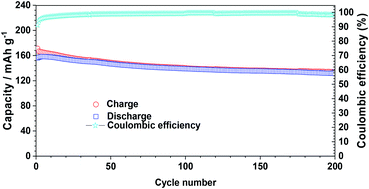All-solid-state interpenetrating network polymer electrolytes for long cycle life of lithium metal batteries†‡
Abstract
A star-shape polymer of 3-armed poly(ethylene glycol) methyl ether methacrylate-co-glycidyl methacrylate copolymer (3PPEGM-co-GMA) was synthesized using an atom transfer radical polymerization (ATRP) technique. All-solid-state interpenetrating network polymer electrolytes (INSPEs) were fabricated by simultaneous reaction of 3PPEGM-co-GMA and bisphenol A diglycidyl ether (BPDE) with polyetherdiamine (ED2003) in the presence of lithium bis(trifluoromethane) sulfonamide (LiTFSI). The INSPEs exhibited ionic conductivities higher than 10−5 S cm−1 at room temperature, a high oxidation stability of 4.5 vs. Li/Li+ and remarkable stability towards lithium metal. Li metal batteries with LiFePO4 as the cathode and INSPEs as the electrolyte cycled at a current rate of 0.1C at 60 °C showed a high initial discharge capacity of 156.2 mA h g−1 and a stable cycling performance over 200 cycles with a high coulombic efficiency of 99%. The results demonstrate that the interpenetrating network polymer electrolytes are promising electrolytes for next generation lithium-based batteries with high ionic conductivity, improved safety, and stable electrochemical performance.



 Please wait while we load your content...
Please wait while we load your content...